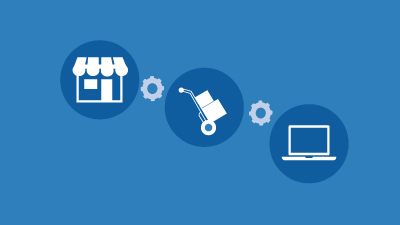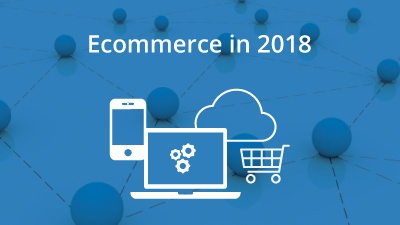Future-Proofing Your Ecommerce Initiatives with Cloud-Built ERP

It’s hard to imagine that ecommerce has existed for more than a quarter century. Though initial forays into buying and selling online relied on complicated processes only available to those well-versed in early 90s internet technology, ecommerce has evolved to provide shoppers with an easier-than-ever buying experience.
Sellers, on the other hand, are at a crossroads. While technologically, it’s easier than ever to get up and running—simply create an Amazon seller account, Shopify/Bigcommerce website, or the like—competing is often the bigger challenge. With more providers than ever, each offering a benefit ranging from two-day shipping to unbeatable pricing, it’s also harder to compete in a market filled to the brim with sellers.
A Big Market for Those Who Can Stay Ahead: Keys to Future-Proofing Your Ecommerce Business
Whether you’re competing for a share of the roughly $5 trillion in global B2C spending or the more than $12 trillion in the B2B space, it’s on you to stay ahead of the changes, evolutions, and trends. If the past ten years have been filled with changes, the next ten will see changes hitting the ecommerce landscape harder and faster than ever.
In this, it’s vital for today’s ecommerce seller to stay ahead of the curve, taking steps to future-proof the business and adapt to changing customer demands. Today, we would like to explore some of the ongoing evolutions to watch and discuss how a true cloud solution keeps you ahead of the trends.
New Searches, New Paths to Purchase
From voice search to augmented reality shopping, the seeds have been put in place for an evolution in the way people buy. Imagine using something like a HoloLens to preview your room before buying a product or relying on an ever-improving home assistant to make orders. The next few years will see the maturation of new buying technologies and processes, requiring you to continue finding ways to meet the customer where they stand.
For those with a bricks-and-clicks environment, this has meant omnichannel and curbside pickup. For pure-play online sellers, this will require a consolidated and device-agnostic shopping experience ready to deliver on consumer expectations whether they’re ordering by speaker, phone, or fridge.
Competing with Manufacturer-to-End User
One of the growing trends in the market has been manufacturer-driven ecommerce. In this, some manufacturers are working to cut out the middle market and sell directly to their end users. Able to offer lower prices, increased customization, and more, you will need to adapt to this threat to offer value to your shoppers.
Staying ahead of Regulatory Changes
With Wayfair now two years old, this case is still sending shockwaves into the community. Wayfair represented a significant and fundamental change in state and local taxation, and companies received just under six months to adjust; most states put economic nexus provisions into effect on January 2019. Now, as simple as it sounds—pass on the sales tax as you would any other retailer—this required a lot of effort on behalf of companies: Completing a state-by-state analysis to determine if and how much tax they need to add on.
Knowing this, it pays to ask what’s next - businesses of all industries need to plan for major changes in local, federal, and global regulation.
Speed and Accuracy are Top Priority
Just a few years ago, two-day shipping was a pipedream—now it’s the norm. Amazon controls and drives the market, meaning it’s only a matter of time before the time gets cut even further. Your ability to deliver rapid shipping and accurate delivery relies on providing your people with the right information.
In the coming years, those with disparate ecommerce processes are going to fall further behind, trying to manage a tangled web of spreadsheets as they build and ship an order. However, those who can connect systems are set up for success, gaining visibility not only into warehouse operations, but finances as well.
For ecommerce businesses, integration is the first step in providing excellent customer service. Your ecommerce platform (website and shopping cart functionality) should be integrated with your ERP and internal functions as much as possible, minimizing duplication and enhancing visibility throughout the value chain.
Acumatica and Cloud 9 ERP: Ecommerce Made Easier
It’s already hard to run an ecommerce business, and even harder if you’re lagging behind the competition. If you’re looking to learn more about how to take your business further with automated, integrated, and configured-for-you ERP software, look no further than Cloud 9 ERP Solutions and Acumatica.
Built in and built for the cloud, Acumatica continues to make the job easier for end users. Whether that’s in the office or the warehouse, Acumatica’s future-proof ERP is built to help you future-proof your ecommerce business.
Learn more about Acumatica’s Integrated ERP and eCommerce software. Contact us today for a free consultation or read more about one company’s journey to better ecommerce below!
Case Study: Caswell Inc. Finds a Steady Future in the Cloud
Acumatica customer Caswell, Inc. (which includes Caswell, British Tools & Fasteners and Mud-Skipper Long Tail Mud Motors) is a family-run operation. It started with President Lance Caswell’s father recognizing that car and bike enthusiasts would restore their old cars and bikes themselves rather than hiring others to restore nickel, brass and other metal plating. From their living room to a manufacturing plant, the company grew in both size and scope, adding two other related companies to the mix. After 13 years of relying on a software package that caused problems during every upgrade and wouldn’t support their add-on company product, Caswell needed a new system.
They chose Acumatica as their integrated ecommerce ERP, implementing our Financial Management and Distribution Management suites. Caswell says, “Acumatica is incredibly simple to use. Acumatica is reliable, and there’s no IT overhead.”
Through the hard work and diligence of Caswell, along with that of Gregg Mercede from Cloud 9 ERP Solutions – an Acumatica Gold Certified Partner – they were up and running in just ten days. And the benefits were immediate. Learn more about Caswell’s journey to the cloud with Acumatica and Cloud 9 ERP Solutions.
Additional Ecommerce Resources
Retailers: Are You Prepared for a Socially-Distanced Holiday Season?
The Ecommerce Pick-Pack-Ship Process
Drop Shipping Management: How ERP Can Help


